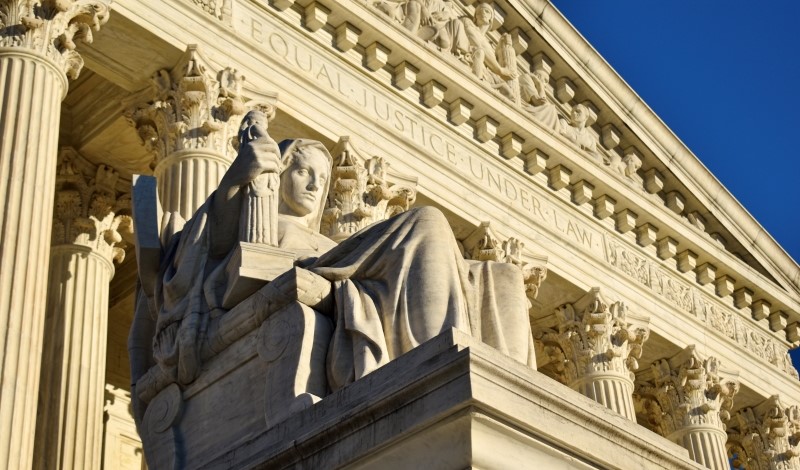
The U.S. Supreme Court’s current docket presents the Court with more opportunities to empower itself at the expense of other governmental institutions.
Litigation in the U.S. Supreme Court has become the right wing’s genteel alternative to open rebellion. The three newest justices, who gave the Court a conservative supermajority, were installed in their posts precisely for the purpose of neutralizing the government. Billionaire-funded advocates declare that the United States is a “shell” of a republic and concede that their goal is to topple the government as it stands. One lawyer helping to wage this assault admits to preferring the Supreme Court as a venue for momentous change because it is “more efficient” than working through the electoral branches of government.
This radical judicial project is well underway. Based on an aggressive and controversial vision of the constitutional separation of powers, the reconfigured Court, spurred on by well-heeled litigants, has already dramatically changed the structure and authority of the federal government. With each new case, the Court has enlarged its own power while shrinking the power of the other institutions of government.
In one set of cases, the Court has attacked the U.S. Congress’s power to ensure a degree of political independence for some agencies. The conservative justices have embraced the view, incubated in the Reagan Administration’s Department of Justice, that the U.S. Constitution requires a “unitary executive.” Under that theory, the President must have control over the hiring and firing of government personnel who, by Congress’s choice, have long enjoyed some degree of independence from presidential influence. Wielding this theory, the Court invalidated Congress’s decision to protect the head of the Consumer Financial Protection Bureau—the most important agency Congress has created in many years—from being fired at the President’s whim. Other, lesser-known agencies have fallen to the same ax. The unitary vision of the presidency also underpins the Court’s efforts to bring administrative law judges closer to presidential control. These judges adjudicate hundreds of thousands of individual cases every year and by law have enjoyed especially strong job security due to their judicial role.
In another set of cases, the Court’s conservative supermajority has undermined Congress’s power to authorize administrative agencies to take on important problems. The Court has recently rejected federal agencies’ efforts, backed by the President, to address climate change, the COVID-19 pandemic, and student loan debt by making up a new rule for legislative drafting which it has dubbed the “major questions doctrine.” Congress may not, the Court has announced, empower an administrative agency to take on an important problem unless Congress speaks super clearly, and also super precisely. Based on this theory, for example, the Court held that the federal workplace health and safety statute broadly empowering the Occupational Safety and Health Administration was not precise enough to authorize a federal rule aiming to stem the spread of the COVID-19 pandemic by requiring either testing or vaccinating personnel in the country’s largest workplaces. The Court explained that the statute covers “workplace hazards,” and that COVID-19 in the workplace is not a workplace hazard because it does not exist only in the workplace. Congress must now, it seems, pass a new, more precise statute every time a new variant on a broad problem threatens the nation.
The justices were apparently so pleased with their new clear-statement requirement that last year they created another one: Congress may not, without “exceedingly clear” direction, “significantly alter” the balance between state and federal power or the power of government over private property. Deploying this open-ended test in Sackett v. EPA, the Court wiped out federal protections under the Clean Water Act for as much as half of the remaining wetlands in the United States.
A curious inconsistency surfaces in this survey of the Court’s emerging jurisprudence on the separation of powers. On the one hand, the Court is busily making the President ever more powerful, with undiluted power to appoint and fire a large group of federal officials. On the other hand, the Court is assiduously working to make the federal officials whom the President supposedly controls—and thus, by extension, the President himself—ever less powerful. The President can fire people, but he cannot make them do anything important. He can break things, but he cannot fix the things that are broken. One way to make sense of these decisions is to notice that the one institution left more powerful after each case is the Supreme Court itself.
The impression that judicial hegemony over the other institutions of government is a feature, not a bug, of the Supreme Court’s evolving jurisprudence deepens with a look at the cases in front of the Court this term. In SEC v. Jarkesy, the Court is being asked to hold that the adjudication overseen by administrative law judges at the U.S. Securities and Exchange Commission violates the constitutional separation of powers and the right to a jury trial. At oral argument in November, most of the conservative justices appeared favorably inclined to the view that civil penalty actions brought by the government against alleged violators of securities laws must be brought in federal court before juries, not before the agency’s own judges. A ruling to this effect would block an enforcement option that Congress has long provided for and will spread uncertainty across the government, as agencies that use in-house adjudicators to resolve disputes—involving a wide range of issues such as collective bargaining, immigration penalties, and customs duties—would be forced to grapple with an entirely new and unpredictable legal landscape.
This year’s docket also includes an array of other administrative law cases arising from different contexts but all threatening to tilt power in the Courts’ favor, away from the other institutions of government. The justices are being asked to countermand scientific judgments made by the Food and Drug Administration in revising dispensing requirements for mifepristone, a medicine used to induce an abortion. They are being asked to block a national air pollution rule predicted to save tens of thousands of lives. And they are being asked to declare that bump stocks—used to fire more than 1,100 rounds in 10 minutes during the deadliest mass shooting in U.S. history—are not “machine guns” within the meaning of federal gun control legislation. Each of these cases swells with the potential for personal and social calamity brought on by judicial overreaching.
In terms of sheer legal upset, however, the blockbusters of this term are two consolidated cases with strangely obscure individual stakes but powerful backers and an ambitious goal: to overturn Chevron v. Natural Resources Defense Council, the most-cited case in all of administrative law. In that 1984 case, the Court held that courts must defer to agencies’ reasonable interpretations of ambiguous statutes. But that holding is in jeopardy in Loper Bright Enterprises v. Raimondo and Relentless v. Department of Commerce. In these cases, private commercial fishing companies—whose lawyers are funded by billionaires—challenge a Department of Commerce rule requiring commercial fishers to pay for private onboard observers who make sure that the fishers comply with rules for fisheries management. The agency indefinitely suspended this rule almost a year ago and will not revive it unless Congress passes a law providing funding for the observers. Nevertheless, the Supreme Court chose this hollow controversy as the vehicle for reconsidering Chevron.
It will be astonishing if Chevron emerges from this litigation without being either shackled or undone. The Court has not deferred to an agency’s interpretation under Chevron since the 2016 case of Cuozzo Speed Technologies v. Lee. And by the time the Court heard oral argument in Loper and Relentless in January of this year, the conservative justices had first been hostile, then silent, for so long about Chevron’s status that the Chief Justice seemed to think that everyone should have already gathered that Chevron is dead. “Have we overruled it in practice?,” he asked. Tellingly, the Court declined to accept review on the narrower statutory question presented in Loper and Relentless, instead taking on only the question of whether Chevron should be overruled. These are cases, then, in which we should expect an avulsive result—one that places unaccountable and unelected courts in the position of interpreting complex statutes that aim to address the United States’ biggest problems.
Absurdly, those asking the Court to overrule Chevron argue simultaneously that Chevron itself deserves no stare decisis respect and that the Court should not worry about the disruption that would come from overruling it because stare decisis will protect the thousands of judicial decisions that have relied on it. How would that work? Chevron’s challengers have a clever argument about how one could describe the thousands of precedents that have grown up around Chevron in a way that makes them robust even if Chevron falls. Perhaps, the lawyers suggest, each of these past decisions could be broadly described as holding their challenged rules to be lawful, rather than narrowly describing them as being dependent on Chevron, and in that way they could survive Chevron’s demise. It is not reassuring that the durability of the enormous body of law relying on Chevron depends on judges not grasping, nor exploiting, the fact that they can shift the precedential value of those decisions simply by manipulating the level of generality at which they describe them.
The stakes of overruling Chevron are greatly amplified by another case on the Court’s docket this term. In Corner Post v. Board of Governors of the Federal Reserve System, the Court has agreed to decide when the six-year statute of limitations for civil lawsuits against the United States, including challenges to agency action brought under the Administrative Procedure Act, begins to run. Does it start to run when the agency action is finalized? Or when the party challenging the action was first injured by it? If the Supreme Court opts for the latter view, then longstanding agency actions may become litigation targets, effectively undermining the point of the time limit on challenges. And if Corner Post wins in the Supreme Court, it might lead the way in the new wave of post-Chevron litigation, as the rule Corner Post challenges was upheld ten years ago based on Chevron deference.
Chevron, as Justice Kagan explained at oral argument, is “a doctrine of humility,” a recognition that “agencies know things that courts do not”—about fisheries, about climate change, about pandemics, about the hydrology of wetlands and water pollution, and about all the complex matters that Congress has charged agencies with addressing. But it is not only disciplinary humility that the conservative justices lack; it is any indication that they value or even respect the actual work that agencies do. If you doubt this, read the oral argument transcripts in Loper and Relentless and spot the many times that conservative justices blasted agencies and their personnel.
Perhaps the most unfortunate consequence of discarding Chevron is that it will mark the Supreme Court’s complete and dangerous transformation into an instrument of the anti-government wing of American politics.




